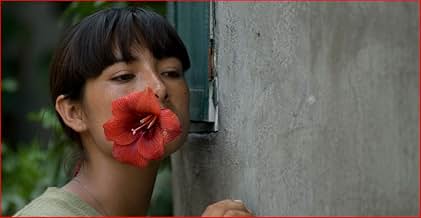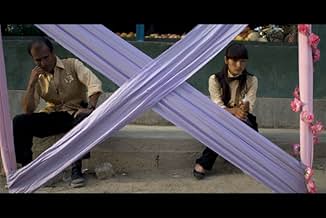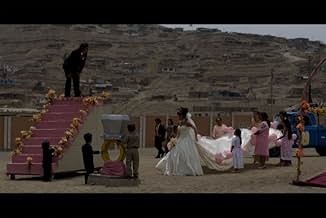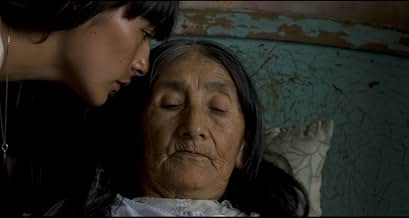VALUTAZIONE IMDb
6,7/10
7556
LA TUA VALUTAZIONE
Fausta soffre di una rara malattia chiamata "Milk of Sorrow", che viene trasmessa attraverso il latte materno delle donne che sono state maltrattate durante o subito dopo la gravidanza.Fausta soffre di una rara malattia chiamata "Milk of Sorrow", che viene trasmessa attraverso il latte materno delle donne che sono state maltrattate durante o subito dopo la gravidanza.Fausta soffre di una rara malattia chiamata "Milk of Sorrow", che viene trasmessa attraverso il latte materno delle donne che sono state maltrattate durante o subito dopo la gravidanza.
- Regia
- Sceneggiatura
- Star
- Candidato a 1 Oscar
- 16 vittorie e 6 candidature totali
Recensioni in evidenza
Young director Claudia Llosa (Madeinusa) has won the Golden Bear and a dozen of other prizes around the world for her second work, The frightened tit, its original Spanish tittle.
Though the plot itself may seem awkward, the movie is a group of 95 minutes rich and beautiful images. The pearls, the potato, the dog, the wedding, the impoverished suburban Lima, everything is accurately directed and carefully thought by Ms. Llosa.
Fausta (outstanding Magaly Solier) is suffering from The frightened tit, an illness that she caught through her mother's breast-milk since her pregnancy happened during the 1980s and 90s terrorism and State violence in the Andes. Now in Lima, Fausta is afraid, she's put a potato in her vagina in order to protect her from being raped, and after her mother dies she finally has to deal with the real life and face her fears,starting to work in a high- class house as a made.
The plot of the movie is fictitious, but it lies on a cruel and past reality of Peru's modern history, combining it with a delicate halo of surrealism, magic realism and sometimes ironic humor. The image of the potato -all time Peruvian ingredient for cuisine- involves the subject of a war and a fear that affected an entire country, though our differences may not accept it yet. The scenes in Fausta's home are the opposite where she works: though the high-class house is in the same impoverished area (another reference to Peruvian social differences), over there is no gray, no dust: there are plants, color, life.
At the end, Fausta realizes that in the root of her fears is the solution of them. The movie, indeed, is presented as a cure for the unhealed wounds of a terrible and recent war that happened on Peruvian soil.
Though the plot itself may seem awkward, the movie is a group of 95 minutes rich and beautiful images. The pearls, the potato, the dog, the wedding, the impoverished suburban Lima, everything is accurately directed and carefully thought by Ms. Llosa.
Fausta (outstanding Magaly Solier) is suffering from The frightened tit, an illness that she caught through her mother's breast-milk since her pregnancy happened during the 1980s and 90s terrorism and State violence in the Andes. Now in Lima, Fausta is afraid, she's put a potato in her vagina in order to protect her from being raped, and after her mother dies she finally has to deal with the real life and face her fears,starting to work in a high- class house as a made.
The plot of the movie is fictitious, but it lies on a cruel and past reality of Peru's modern history, combining it with a delicate halo of surrealism, magic realism and sometimes ironic humor. The image of the potato -all time Peruvian ingredient for cuisine- involves the subject of a war and a fear that affected an entire country, though our differences may not accept it yet. The scenes in Fausta's home are the opposite where she works: though the high-class house is in the same impoverished area (another reference to Peruvian social differences), over there is no gray, no dust: there are plants, color, life.
At the end, Fausta realizes that in the root of her fears is the solution of them. The movie, indeed, is presented as a cure for the unhealed wounds of a terrible and recent war that happened on Peruvian soil.
Our heroine is called Fausta, a girl who is full of fear. "The Milk of Sorrow" or, more exactly "The Frightened Tit" is, in the Peruvian-indigenous tradition, an illness, is being condemned to be a coward. Peru's late History was influenced by guerrilla's warfare and state brutality. Women (like Fausta's mother) were raped, and raped women got sick... of fear. through her mother's milk Fausta is afraid of life, but she is by no mean a coward, because after her mother dies, her struggle is by herself. This movie is beautiful, it combines a very, very strong performance from Magaly Solier, and a universal human struggle in a very typical Latin American city.
I was so touched by this film, which is obviously a low budget production. It proves that you do not need a multi-billion budget to make a good movie. I think only women can understand fully the pain and the fear the heroine had to go through. I wonder if they produce a sound track for the movie. The songs by the heroine and that sonata adopted by the pianist were beautiful. Solier is a great actress and her facial features, well, what can I say, is not the kind of glamour you find on screens. She has character, reflecting her heritage. I immediately take a liking of her from the first few scenes.I It is disturbing to find people snubbing such a beautiful movie but I guess everyone to his/her tase.
Claudia Llosa writes a peculiar, but captivating story of a young Peruvian girl living in a constant world of fear on the outskirts of Lima. Fausta is believed to be suffering from a rare disease, "La teta asustada," or the "Milk of Sorrow," which was transmitted from her mother's breast milk after she was raped by terrorists during the time of Sendero Luminoso. Facing her mother's death, Fausta is forced to overcome her fear and work in the Big House of a limeña musician. While both the music and filming are stunning, I feel that the film lacks much action or thick plot. I found it to be more of a journey, one that led Fausta from her fear to a glimpse of her freedom. Furthermore, as a viewer who has lived in Peru, the film was very nostalgic for me and I felt that it portrayed Lima and the "pueblos" with a profound sincerity.
If you are looking for a poetic and beautiful journey of a story, this film is exactly that.
If you are looking for a poetic and beautiful journey of a story, this film is exactly that.
I can see that or why many people will like this movie. There is the very great portrayal of the main actress, there is running theme in here that speaks to many art-house fans (even those who may not know that they are).
The pacing might seem awkward, some twists in the story line and/or character arc, might not be accessible to some viewers, but all those things make the movie even better. At least that's how I see it. Still as this is a movie that provokes or encourages you to think a lot, there might come up a few questions, story-wise and or character-wise that might leave you with a slightly bad taste.
And although up until now the review the user GeneralGrievous gave hasn't received positive feedback, you have to cut the guy some slack. If you read his review, you can understand why he didn't like the movie quite as much. I thought his review was helpful, even though I don't agree on everything he writes, because he explains not only why he thinks that way, but he gives a few glimpses into his knowledge of Peruvian film-making.
The pacing might seem awkward, some twists in the story line and/or character arc, might not be accessible to some viewers, but all those things make the movie even better. At least that's how I see it. Still as this is a movie that provokes or encourages you to think a lot, there might come up a few questions, story-wise and or character-wise that might leave you with a slightly bad taste.
And although up until now the review the user GeneralGrievous gave hasn't received positive feedback, you have to cut the guy some slack. If you read his review, you can understand why he didn't like the movie quite as much. I thought his review was helpful, even though I don't agree on everything he writes, because he explains not only why he thinks that way, but he gives a few glimpses into his knowledge of Peruvian film-making.
Lo sapevi?
- QuizMagaly Solier used to sell Puca picante (Andean treat) in the street before she was discovered by Claudia Llosa in 2005 while looking for extras for Madeinusa (her first film). Now she's a recognized actress and talented singer.
- ConnessioniFeatured in Brief Film Reviews: The Milk of Sorrow (2010)
- Colonne sonoreQuizás algún día
Music by Magaly Solier
Lyrics by Claudia Llosa
Performed by Magaly Solier and Bárbara Lazón
I più visti
Accedi per valutare e creare un elenco di titoli salvati per ottenere consigli personalizzati
- How long is The Milk of Sorrow?Powered by Alexa
Dettagli
Botteghino
- Lordo Stati Uniti e Canada
- 10.462 USD
- Fine settimana di apertura Stati Uniti e Canada
- 1914 USD
- 29 ago 2010
- Lordo in tutto il mondo
- 1.557.750 USD
- Tempo di esecuzione
- 1h 35min(95 min)
- Colore
- Mix di suoni
- Proporzioni
- 1.85 : 1
Contribuisci a questa pagina
Suggerisci una modifica o aggiungi i contenuti mancanti






















